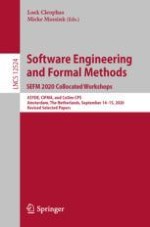This volume constitutes the revised selected papers from the three workshops collocated with the 18th International Conference on Software Engineering and Formal Methods, SEFM 2020, held in Amsterdam, The Netherlands, in September 2020.
The 15 full papers presented together with 8 short papers in this volume were carefully reviewed and selected from a total of 35 submissions. The contributions that are collected in this volume have been selected from the presentations at the following workshops:
ASYDE 2020: Second International Workshop on Automated and Verifiable Software System Development; CIFMA 2020: Second International Workshop on Cognition: Interdisciplinary Foundations, Models and Applications; and CoSim-CPS 2020: Fourth International Workshop on Formal Co-Simulation of Cyber-Physical Systems.
Due to the Corona pandemic this event was held virtually.

 , reproduces their examples and shows how to model check runtime traces and algorithms with this formalization. The formalized model in
, reproduces their examples and shows how to model check runtime traces and algorithms with this formalization. The formalized model in
 enables semi-automatic model checking for different implementation alternatives for transactional operations and allows checking of conformance to isolation levels. We reproduce examples of the original paper and confirm the isolation guarantees of the combination of the well-known 2-phase locking and 2-phase commit algorithms. Using model checking this formalization can also help finding bugs in incorrect specifications. This improves feasibility of automated checking of isolation guarantees in synthesized synchronization implementations and it provides an environment for experimenting with new designs.
enables semi-automatic model checking for different implementation alternatives for transactional operations and allows checking of conformance to isolation levels. We reproduce examples of the original paper and confirm the isolation guarantees of the combination of the well-known 2-phase locking and 2-phase commit algorithms. Using model checking this formalization can also help finding bugs in incorrect specifications. This improves feasibility of automated checking of isolation guarantees in synthesized synchronization implementations and it provides an environment for experimenting with new designs.